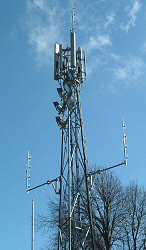


   |
TETRA masts: like household lightbulbs?! |
|||
|
Extremely low frequency pulsed electromagnetic radiation does affect living organisms. That means you and me. We are the experiment. |
The TETRA Intensity Myth This article addresses the flawed and familiar TETRA myth: ‘The emissions of a TETRA base-station are comparable to that of only a 40W light bulb, and thus equally harmless.’ It should first be noted that Airwave masts (unlike Dolphin TETRA masts or GSM phone masts) are always on and transmitting, even when there is no traffic on the network. Next, a TETRA base station can, and often does, use four transmitters on a mast. According to the TETRA standard, the maximum power output of each transmitter is 40 Watts (46dBm). [And this is (a) much more efficient than an incandescent lightbulb working at 10 per cent conversion of power to light, and (b) much more focussed than spherical radiation.] Therefore the total power must be multiplied by 4 giving 160 Watts.[1] Further to this, the gain of the antennae must be taken into consideration. The gain of a 120-degree sector antenna (the ones with the four folded dipoles along them) can be up to 20 (13dB). This gives us a final figure of 160 x 20 = 3,200 Watts or 3.2 kW. So, we have already exceeded the 40W light bulb by a factor of 80 times, but it doesn’t end there – there is the frequency dimension to be considered. To fully appreciate the difference between a 40W light source and a 3,200W microwave source, we need to understand the fact that light and microwaves are different kinds of electromagnetic (EM) radiation. The thing that makes them different is their frequency, and that the energy of any kind of EM radiation is proportional to its frequency. This notion of energy and frequency leads us to the concept of a ‘packet’ of EM radiation, known as the photon. Each photon at a particular frequency will have the same energy, but a photon of light will have a far greater energy than a microwave photon. In fact the difference is enormous: frequency of light: 600,000,000,000,000 Hz frequency of TETRA microwaves: 400,000,000 Hz Therefore, we can say that one photon of light carries: (6,000,000 / 4) = 1,500,000 times more energy than one microwave photon. Now, since each TETRA microwave photon carries such little energy compared to a light photon, there must be an enormous number of them being emitted per second to carry the 3,200 Watts of energy. The ratio of TETRA photons to light photons from the 40W bulb would be as follows: 1,500,000 x 3200 / 40 = 120,000,000 This means that if you were to stand near a transmitting TETRA mast, with a regular 40W light bulb on it as well, you would be assaulted by 120-million times the number of TETRA photons than light photons. For the same emitted rate of light photons, you would need either one 4.8 billion-Watt bulb (4,800 mega-Watts) or 120 million 40W bulbs. This means that every person in the UK would have to give you 2 light bulbs each! Also, bear in mind that the TETRA radiation would penetrate into your body, the light would not. But what’s the big deal? At the end of the day, the intensity of the radiation is still very low – far too low to cause heating. The answer lies in the fact that the pulsed nature of the emissions from TETRA masts (and handsets) is coherent (or organised). This means that it is characterised by a number of well-defined frequencies and as such, interferes with various biochemical processes in the body. Indeed, it is this high level of coherence which makes the signal so discernable to the living human organism, which has evolved in an environment entirely devoid of this kind of radiation. For further reading: ‘How Exposure to GSM and TETRA Base-station Radiation can Adversely Affect Humans’, Gerard J Hyland, August 2003. Biological Effects of Microwaves and Mobile Telephony, K. Sri Nageswari, India On the imprecision of measuring intensity and lack of understanding on health effects (Anne Silk)
[1] We are told in the NRPB documentation (Vol 12 No 2 2001) that due to losses in the combiner and connecting cabling, the total power is about one-third of the combined output of each transmitter. <back> Ian Sharp |
 TETRA: your local friendly lightbulb! Residents around the Woodside Road Football Ground are used to both floodlights and mobile phone masts. This one is different... |
|
Home | |||